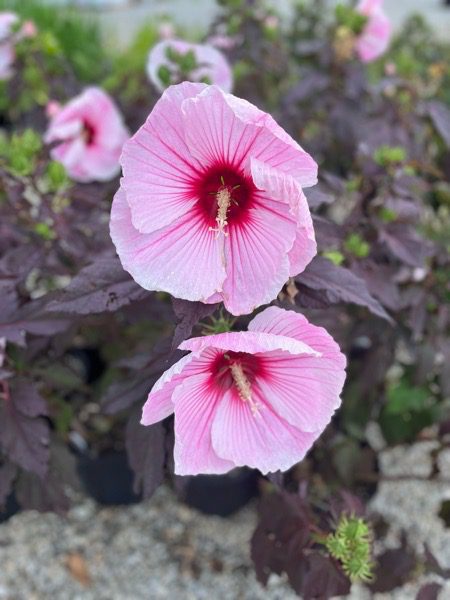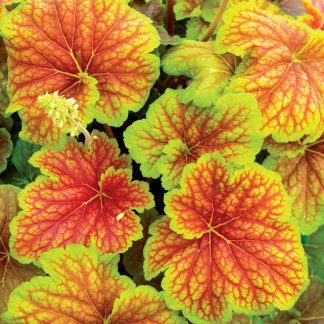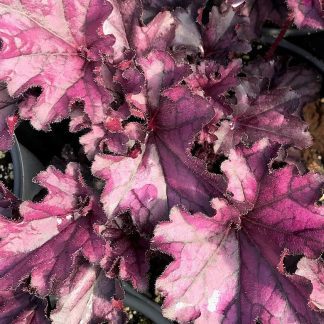Description
Hibiscus ‘Starry Starry Night’: A Celestial Bloom for the Garden
Hibiscus ‘Starry Starry Night’ is a perennial hibiscus that feels like a work of art. Its petals look hand-painted, with soft pink brushstrokes radiating from a deep red center across pale pink petals. Combined with its dark, almost black foliage, this plant delivers contrast and elegance in a way few perennials can match.
It’s part of the Summerific® series, known for hardy hibiscus varieties that withstand cold winters while bringing tropical-scale blooms to summer gardens. In this guide, we explore everything you need to know about Hibiscus ‘Starry Starry Night,’ from planting and care to design tips and why it’s a favorite for pollinator-friendly landscapes.
The Look: Painted Petals and Dark Foliage
Starry Starry Night’s flowers are enormous — often 7 to 8 inches across — with soft pink petals brushed with darker veins and a vivid red eye at the center. These blooms appear in midsummer and continue well into fall, opening fresh each day to create a nonstop display.
The foliage is equally striking. Deep burgundy leaves form a dense backdrop that makes the pale blooms stand out even more. This combination of dark leaves and watercolor petals gives the plant a dramatic yet romantic feel.
Growth Habit and Size
Starry Starry Night forms a compact, rounded mound that reaches about 3 to 4 feet tall and wide. This moderate size makes it versatile for both borders and containers. Despite its tropical look, it’s a true hardy hibiscus, returning each spring even in colder climates.
The plant emerges late in spring, often after many other perennials have already sprouted. This is normal — hardy hibiscus are slow to wake up but grow quickly once warm weather arrives.
Best Planting Location
Starry Starry Night thrives in full sun. At least six hours of direct sunlight daily ensures vibrant foliage and abundant blooms. While it can tolerate light shade, fewer flowers and lighter leaf color may result.
The ideal soil is rich, moist, and well-drained. Hardy hibiscus love consistent moisture but dislike standing water. Amending the soil with compost improves fertility and drainage, helping the plant thrive.
Good airflow around the plant reduces the risk of fungal diseases like mildew or leaf spot, especially in humid climates.
Planting Guide
- Plant in warm weather – Wait until late spring or early summer when soil temperatures are warm and frost danger has passed.
- Prepare the soil – Loosen soil and mix in compost or organic matter to improve texture and nutrients.
- Dig the hole – Twice the width of the root ball, but no deeper.
- Set the plant – Place the root ball level with the soil surface.
- Backfill and water – Fill the hole, press soil gently to remove air pockets, and water thoroughly.
- Mulch generously – A 2-3 inch mulch layer conserves moisture and prevents weeds.
Watering and Fertilizing
Starry Starry Night needs consistent moisture, especially during its bloom season. Deep waterings two to three times per week are ideal. Avoid letting the soil dry out completely, as this can stress the plant and cause buds to drop.
Fertilize in spring with a balanced fertilizer or one slightly higher in potassium for flower production. Reapply every four to six weeks during summer to maintain steady growth and blooms. Stop feeding in late summer to allow the plant to prepare for dormancy.
Pruning and Maintenance
Pruning hardy hibiscus is straightforward. In late fall or early spring, cut stems down to about 6 inches above the ground. New growth will emerge from the base as the weather warms.
Deadheading spent blooms is optional. Each flower lasts only a day or two, but the plant produces new buds continuously, so the display remains fresh even without deadheading.
Winter Hardiness
Starry Starry Night is hardy in USDA zones 4–9. After frost, the top growth dies back to the ground, but the roots remain alive underground. Apply mulch in late fall to protect the crown during winter.
In spring, be patient — hardy hibiscus are slow to emerge and may not show growth until early summer. Once they start growing, they quickly catch up and produce massive blooms by midsummer.
Comparing Starry Starry Night to Other Hardy Hibiscus
Starry Starry Night’s soft pink veined petals and dark foliage set it apart from other hardy hibiscus. While varieties like ‘Dark Mystery’ feature pure white blooms, and ‘Berry Awesome’ leans toward lavender-pink, Starry Starry Night combines both a unique veining pattern and rich foliage color.
For gardeners wanting a plant with artistic blooms and strong contrast, Starry Starry Night delivers a perfect balance of drama and charm.
Pollinator Appeal
The open flowers are irresistible to hummingbirds, bees, and butterflies. The deep red eye serves as a nectar guide, leading pollinators directly to the reward. By planting Starry Starry Night, you add both beauty and ecological value to your garden.
Companion Planting Ideas
Pair Starry Starry Night with plants that enhance its soft pink blooms and dark foliage:
- Silver and gray foliage – Russian sage, dusty miller, or lamb’s ear provide soft contrast.
- Purple and blue perennials – Lavender, salvia, or catmint complement the flower’s pink tones.
- Bright yellow blooms – Black-eyed Susans or coreopsis add cheerful contrast.
- Ornamental grasses – Their fine texture balances the hibiscus’s bold flowers and leaves.
Plant it as a focal point in borders, group three or more for impact, or use it in large containers for patios and decks.
Container Growing Tips
Starry Starry Night thrives in large containers when given proper care. Use pots at least 18–20 inches wide and deep. Choose a high-quality potting mix with good drainage.
Water containers frequently, especially during hot weather, as they dry out faster than garden beds. Fertilize every two to three weeks with a balanced liquid fertilizer during the growing season. In colder zones, move containers to a sheltered spot or insulate them for winter protection.
Pests and Problems
Hardy hibiscus are generally easy to grow but may encounter:
- Aphids – Spray with water or treat with insecticidal soap.
- Japanese beetles – Handpick or use traps placed away from the plant.
- Leaf spot or mildew – Encourage airflow and avoid overhead watering to prevent fungal issues.
Most problems are minor and easily managed with simple care.
Propagation
You can propagate Starry Starry Night through division or softwood cuttings. In spring, divide mature clumps and replant them immediately. For cuttings, take young shoots in early summer and root them in moist soil or water.
This is an easy way to expand your collection or share this unique hibiscus with friends and family.
Seasonal Highlights
- Spring – Slowly emerges; deep burgundy leaves appear.
- Summer – Peak bloom season; hand-painted pink flowers cover the plant.
- Fall – Flowers continue until frost; foliage adds lasting color.
- Winter – Dormant period; mulch protects the crown for next season’s growth.
Why Gardeners Love Starry Starry Night
Gardeners adore this hibiscus for its artistic flowers and dark foliage. It offers bold summer color but with a romantic touch, blending well into both modern and cottage-style gardens. Its reliable performance and ease of care make it a favorite for those seeking maximum impact with minimal fuss.
A Showpiece for Every Garden Style
Starry Starry Night fits effortlessly into pollinator gardens, mixed borders, and even contemporary landscapes. Its dark leaves provide structure and depth, while its veined pink blooms add softness and movement. Whether planted alone or combined with other hardy hibiscus varieties, it delivers a dramatic yet harmonious display.
A Plant That Feels Like Living Art
There’s a painterly quality to Starry Starry Night. Its blooms look brushed by hand, shifting in tone as the sun moves across the sky. Paired with nearly black foliage, it creates an ever-changing display that feels alive with color and contrast.
Celestial Blooms for Endless Summers
Planting Hibiscus ‘Starry Starry Night’ is like adding a piece of art to your garden. Its enormous flowers, unique veining, and dramatic foliage transform sunny spaces into living galleries. With minimal care and reliable performance, it returns each year, bigger and more beautiful than before.
When midsummer arrives and the first blooms open, you’ll understand the name — every flower feels like a star-strewn masterpiece waiting to be admired.




